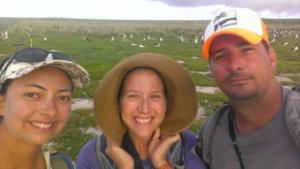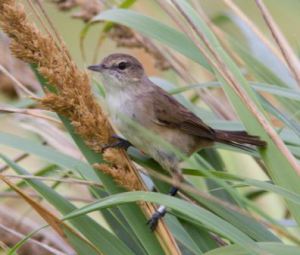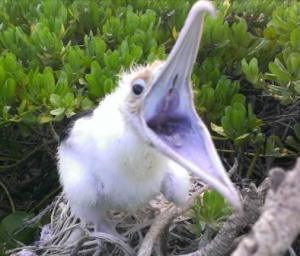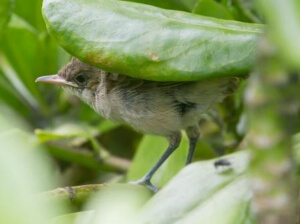Fresh Meat for Flies: First Impressions of Laysan Island
July 7, 2014
It has been a week since I arrived on Laysan Island with fellow field biologists Megan Dalton and Robby Kohley. We have been sent to Laysan, a small island in the Northwest Hawaiian chain about 930 miles northwest from Honolulu, to monitor a population of translocated Millerbirds. The last time anyone checked on the Millerbirds was in September 2013, when Megan, Michelle Wilcox, and Andrea Kristof departed.

The Millerbird monitoring team on Laysan (left to right): Megan Dalton, Barbara Heindl, and Robby Kohley. Laysan Albatrosses are also seen in the background. Photo by Barbara Heindl
In 2011 and 2012, a total of 50 individual Millerbirds were brought from Nihoa Island to Laysan Island, where Millerbirds had been extinct on the island for almost 100 years. The original Laysan Millerbird population went extinct because of habitat degradation caused by introduced, non-native rabbits. Once the rabbits were eradicated, and decades of habitat restoration completed by USFWS Refuges, the Millerbirds were translocated.
Life in the Field: Adaptation
When you start a new field job there is always a transition period. The period of time where everything is new, your assumptions about the location and experience are either met or modified. You develop a flow with your new co-workers who are also the people you will be living with for the next several months. You are forced to compare all your new experiences to your old ones and for the most part, maybe more than anything else, are trying to cope with how to take in everything, new guidelines, new living quarters, new background noises, everything.
I am not sure whether this experience has been eased or complicated by my working almost exclusively on Kaua‘i, the closest (~800 mi) inhabited island in the main Hawaiian chain, for the last five years.
On “Gilligan's Island”
Everything on Laysan is still part of Hawai‘i, but at the same time different from the Hawai‘i I have previously experienced. It is undeniably closer to what my family and friends from the mainland visualize. An ocean view backdrops every image I lay my eyes on. Gilligan's Island is a close approximation, and the coconut wireless is real, though no one has managed to engineer an FM/AM coconut radio yet. But otherwise it is a stark contrast from the work I have been doing for the past 5 years.
Working for the Kaua‘i Forest Bird Recovery Project, my “office” was the Alaka‘i Swamp in montane rainforest at the uppermost elevations of Kaua‘i. The Alaka‘i is a tangled jungle-gym of forest where, while you may see rainbows at the end of the day, it is likely because you have just endured or are still sitting in a torrential downpour. Working there you are constantly tripped by vines and low branches, and often fight to get through dense woven masses of ‘ohe naupaka or shrub ‘ōhi‘a, a task that requires not only the patience of a saint but also the zen-like resolve of a monk.
Bird Detection in NIMI Land
On Laysan, in what is fondly referred to as “NIMI land” (NIMI being the field code for Nihoa Millerbird), I have traded in that familiar tangled mess of twisted shrub ‘ōhi‘a for tangled beach naupaka (a native coastal shrub). The main difference being that beneath the matted naupaka are countless nesting Wedge-tailed Shearwaters, Red-tailed Tropicbirds, Brown Noddies and, of course, Nihoa Millerbirds. All of which makes every step an exercise in decision-making and a lesson on the effects of one's footsteps on an environment not made for humans.
Detecting Millerbirds is far more difficult then I initially expected. I am used to detecting birds, in most situations by sound first, and usually I am able to narrow the location down and get visual confirmation shortly thereafter. While the Millerbird song and calls are distinct, they are fragile and can be hard to pick out through the deafening din of Great Frigatebird and Red-footed Booby nestlings begging for food. Sooty Terns and Noddies swooping above you don't help either while you are trying to focus on the mouse-sized Millerbirds secretively hopping around the underbrush.
On Kaua'i a “busy” bird survey might become more difficult if you are flanked by a single upset Kaua‘i ‘Elepaio or a chatty Japanese White-eye, both of which might make detecting the ever-decreasing ‘Akikiki or ‘Akeke‘e difficult. These distractions are nowhere near the cacophonous sound of upset seabirds and hoards of flies buzzing in your ears, eyes, and nose. Even keeping in mind that the Millerbird is only one of two songbirds on the island, the social and consistent melody of the Laysan Finch can easily cover and mask a nearby Millerbird's gentle “chk chk” call as well.
Toward a Future with Many Millerbirds
I have been repeatedly amazed and so thankful to be joined in the field with Millerbird veterans Robby and Megan. They both have been involved at critical stages of the Nihoa Millerbird project, including the two translocations and the transition to monitoring the growth and success of the new population.
Their skill and proficiency in this environment is not only impressive, but has also been a valuable resource for me in learning the ropes during our first week on the island. They can detect the light song of a Millerbird tens of meters away, when all I hear are the primordial shrieks of Frigatebirds directly above us.

Millerbird known as "Black over Silver, Blue over Orange" for the colors of its bands, perched in a native bunch grass on Laysan. Photo: Robby Kohley
The few interactions I've had with Millerbirds so far have been deeply rewarding, all thanks to these two seasoned biologists. I'm looking forward to seeing what the next three months bring, especially as I start to get my feet under me in the field, both figuratively and metaphorically. Whatever the future brings, here's to hoping there are lots of Millerbirds in it!
Editor's Note: ABC helped translocate the Millerbirds to Laysan from their last remaining habitat on Nihoa Island during 2011-2012 and continues to support the project. A “founder population” of the birds more than doubled its original population of 50 birds to 121 in 2013, offering increased promise for the species' future.
Barbara Heindl is a field biologist on Laysan Island monitoring translocated Nihoa Millerbirds. She has also done extensive work on Kaua‘i, Hawai'i, Alaska, and across the United States' mainland. She is originally from Wisconsin and a graduate of University of Wisconsin-Madison.





















































